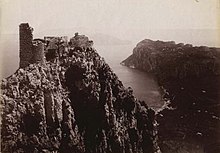
Axel Martin Fredrik Munthe was a Swedish-born medical doctor and psychiatrist, best known as the author of The Story of San Michele, an autobiographical account of his life and work. He spoke several languages, grew up in Sweden, attended medical school there, then studied medicine in Paris and opened his first practice in France. He was married to a wealthy Englishwoman and spent most of his adult life in Italy. His philanthropic nature often led him to treat the poor without charge, and he risked his life on several occasions to offer medical help in times of war, disaster, or plague. As an advocate of animal rights, he purchased land to create a bird sanctuary near his home in Italy, argued for bans on painful traps, and himself kept pets as diverse as an owl and a baboon, as well as many types of dog. His writing is light-hearted, being primarily memoirs drawn from his real-life experiences, but it is often tinged with sadness or tragedy, and often uses dramatic licence. He primarily wrote about people and their idiosyncrasies, portraying the foibles of both the rich and the poor, but also about animals.

Capri is an island located in the Tyrrhenian Sea off the Sorrento Peninsula, on the south side of the Gulf of Naples in the Campania region of Italy. The main town Capri that is located on the island shares the name. It has been a resort since the time of the Roman Republic.

The Villa San Michele was built about the end of the 19th century on the isle of Capri, Italy, by the Swedish physician and author Axel Munthe.
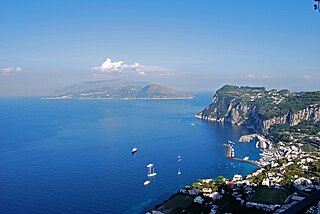
Anacapri is a comune on the island of Capri, in the Metropolitan City of Naples, Italy.
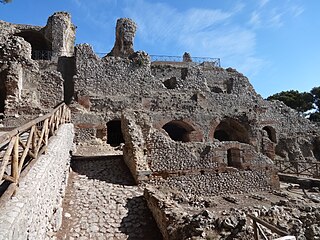
Villa Jovis is a Roman palace on Capri, southern Italy, built by emperor Tiberius and completed in AD 27. Tiberius ruled mainly from there until his death in AD 37.

Hayreddin Barbarossa, also known as Hızır Hayrettin Pasha, and simply Hızır Reis, was an Ottoman corsair and later admiral of the Ottoman Navy. Barbarossa's naval victories secured Ottoman dominance over the Mediterranean during the mid 16th century.
The island of Capri is situated in the Gulf of Naples, between the Italian Peninsula and the islands of Procida and Ischia. Made of limestone, its lowest part is at the center, while its sides are high and mostly surrounded by steep precipices, which contain numerous caves. Its topography is dominated by the slopes of the Monte Solaro in the West and Monte San Michele the East.

The Castelli di Cannero are three rocky islets of Lake Maggiore in northern Italy. They are located off the shoreline of Cannero Riviera while administratively forming part of the Comune of Cannobio. They are known as castelli, or castles, in recognition of the ruined ancient fortifications which are found on two of them. They are all that remains of the Rocca Vitaliana fortress built between 1519 and 1521 by Ludovico Borromeo, who gave it this name in honour of an illustrious ancestor.
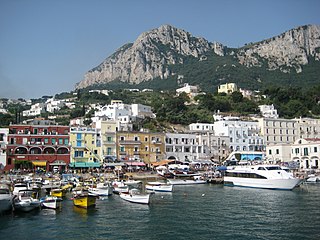
Capri is a municipality, in the Metropolitan City of Naples, situated on the island of Capri in Italy. It comprises the centre and East of the island, while the West belongs to Anacapri.
Salah Rais was the 7th King of Algiers, an Ottoman privateer and admiral. He is alternatively referred to as Sala Reis, Salih Rais, Salek Rais and Cale Arraez in several European sources, particularly in Spain, France and Italy.

The Koules or Castello a Mare is a fortress located at the entrance of the old port of Heraklion, Crete, Greece. It was built by the Republic of Venice in the early 16th century, and is still in good condition today.
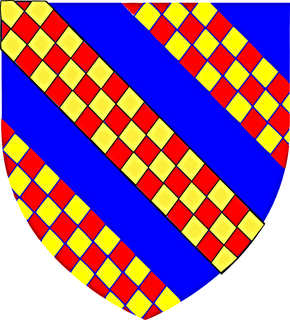
The Solaro family was the most powerful medieval banking family in Asti, Italy. At the height of their power, they were owners of 24 castles within Asti's communal territory. They were also present in Genoa in the 12th century and acquired holdings in Sestri Levante. Of the Casane Astigiane, they were the main Guelf supporters in Asti, in contrast to the 'De Castello" union.

Monte Solaro is a mountain on the island of Capri in Campania, Italy. With an elevation of 589 m, its peak is the highest point of Capri.

Marina Grande is the main port of the island of Capri in Italy, to the north of the main town of Capri and at the foot of Mount Solaro.
The Grotta dell' Arco is a large, shallow cave on the island of Capri, Italy. It faces east, and is situated about 240 m above sea level, under the cliffs which are south-east of the Castello Barbarossa. The cave is about 85 feet (26 m) in height and may have resulted from the great landslide which occurred at the east of Monte Solaro.

Santa Sofia is a Roman catholic church located in the Piazza of Anacapri, on the island of Capri, Italy. It dates to 1596 when it replaced Chiesa di Santa Maria di Costantinopoli as the parish church. Some of the building materials and fittings, such as the sacristy and oratorio, were originally in the Chiesa di San Carlo. The church chapels are dedicated to Sant'Antonio, Anacapri's patron saint, and the Madonna del Buon Consiglio. Architectural features include two bell towers and a baroque facade. The wedding of Guiliana DePandi and Bill Rancic occurred at the Chiesa di Santa Sofia.
Chiesa di Santa Maria di Costantinopoli is a church located in the Li Curti district of Anacapri, on the island of Capri, Italy. Built in the eleventh century and restored in the seventeenth century, its architectural features include Gothic and Byzantine elements. It contains several works by the Flemish painter Willem Borremans. At one time the parish church of Anacapri, the Chiesa di Santa Maria di Costantinopoli was replaced by the Chiesa di Santa Sofia in that role.
Santa Maria a Cetrella is a Franciscan chapel and hermitage in Anacapri, Capri, Italy. Referred to as "Capri's most otherworldly church", it contains a Madonna statue which is venerated by pilgrims, including Rainer Maria Rilke. Built in the Middle Ages, its features include stucco siding, with a low-vaulted ceiling.

The Castello di Montesegale or Castle of Montesegale is a rural hilltop medieval fortress in the hamlet of Montesegale, Province of Pavia, region of Lombardy, Italy.
